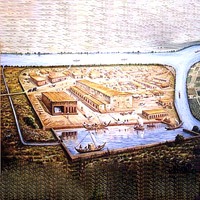Rise and fall of civilizations is a complex phenomenon. No single factor is responsible for such a colossal event. Although there are five theories about the fall of Indus civilization but all of them are based on imagination and nothing can be said with complete conviction. It is said that the most important factor was the exhaustion of resources. Continuous growth of wheat only, the soil lost its fertility with the result the people of Indus Civilization started migrating to South India where they began to cultivate rice.
Another speculation is that it was due to some colossal flood that brought havoc and eliminated the important cities of this civilization. Or it was the sudden rise in the Arabian Sea level that wiped out the Indus civilization because in 1960, a seaport of this civilization was found at 30 miles deep in the water. Some researchers believe the peaceful life of the Indus people bred a sense of complacency and that they were not strong enough to keep away violent and mighty invaders. Therefore they encountered little or no resistance when all of a sudden the Aryan invaders poured in from the Northwest. City after city fell, and the pathetic remains of the people were either assimilated into the conquerors’ way of life, or they fled further south. In this way the fall of Moenjodaro, almost 3,500 years ago typified this decay. The invaders were nomadic people, unused to urban life. They revered all natural phenomena, ascribing divinity to animals, the wind, the trees, the sky, the moon and the sun, among myriad of others. It was during this age that the Vedas began to be composed and formed the basis of early Hinduism.
Actually, in or about 1500 BC, the Aryans descended upon the Punjab and settled in the Sapta Sindhu, which signifies the Indus plain. They developed a pastoral society that grew into the Rigvedic Civilization. The Rigveda is replete with hymns of praise for this region, which they describe as “God-fashioned”. No doubt as long as the Sapta Sindhu remained the core of the Aryan Civilization, it remained free from the offensive and abhorrent caste system in the Gangetic Valley. Anyhow, apart from the caste system, there is no denying the fact that the Indus Civilization contributed much to the development of the Aryan Society. By chance, the discovery of the Gandhara graves in Dir and Swat will go a long way in comprehending cultural history of this land between the end of the Indus Culture in 1500 BC and the beginning of the historic period under the Achaemenians in the sixth century BC. So instead of the Aryan invasion as mentioned above, Hindu mythology and Sanskrit literary traditions seem to attribute the destruction of the Indus Civilization to the Aryans. However, what really happened, remains a pre-historic enigma that still remains to the solved.
This article was last updated on Monday, Jan 03, 2005






